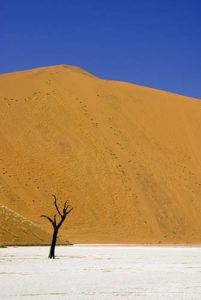
Namibia: Sossusvlei dune with dead tree in Deadvlei salt pan at Namib-Naukluft Park. Photo by Dennis Cox/WorldViews
Here’s Part II of Robert Waite’s account of 12 days of traveling through Namibia, a remarkable desert land wedged in a corner of southwest Africa between Angola and South Africa.
(If you missed Part I of Bob’s Namibia narrative, read it here.)
In this piece, Bob encounters towering sand dunes, otherworldly dried lakes, a bay cruise complete with some of the world’s best oysters, a visit to Damaraland, and a top-flight game park where one may encounter lions and herds of elephants and zebras.
By Robert Waite
Walvis Bay, Namibia – If you know Namibia at all, it is likely because of the country’s sand dunes, the largest on earth.
I grew up in Massachusetts, close to Crane Beach in Ipswich. We locals would brag about our “huge” 30-40 foot dunes. It was a bit like someone from Tucson bragging about the height of the skyline, having never been to San Francisco or New York.
Namibia’s dunes, located in Namib-Naukluft National Park, stretch upwards of 400 meters (1,300 feet) above a sandstone base and, thanks to constant wind, are sculpted and re-sculpted endlessly.
The park opens at dawn, so we were up very early and poised to be among the first to enter – until someone in a nearby vehicle pointed out our bus had a flat tire. This produced something of a comedy of errors, with our hulking, broad-backed driver, Udo, struggling to loosen the lug nuts and a diminutive German physician, Gudrun, stepping in to finish the job. Score one for the women.
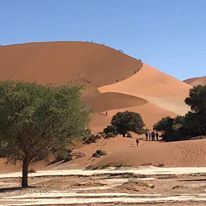
Dune 45 is more than 1,300 feet high. Photo by Robert Waite
We were no longer first in line, but it really didn’t matter – there is enough to see and enough room to spread out to accommodate everyone.
One of the most notable area features is Deadvlei, a white clay “pan” or dried lake, which can be reached by a moderate hike over and around some smaller dunes. As you approach, the scene is other-worldly – indeed, several films have been shot here over the years for just that reason.
Stranded Trees
Stranded in the bright-white lake bed are trees that met their end 600-700 years ago, when the water ran out. They are not petrified, as you might find in Arizona or Turkey; it is simply just too dry for them to decompose. If you are a photographer, the landscape makes for truly striking images.
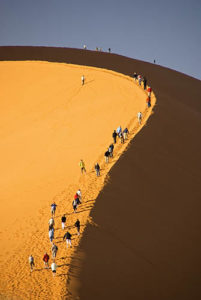
Namibia: Climbers on Dune 45 at Sossusvlei sand dune in Naukluft Park. Photo by Dennis Cox/WorldViews
At Sossusvlei there is another pan to visit, but here the real attraction is the dunes. They are numbered, starting from the mostly dry Tsauchab River. The most visited (and photographed) are numbers seven and 45.
One reason for the early start is to view the dunes in the light of a rising sun, which creates dramatic shadowy contrasts and enhances their reddish hue. This combination of light, sculptured shape and vivid color is truly unique – one of the most beautiful vistas I have experienced anywhere on earth.
And you don’t just have to admire from afar – you can climb these pyramid-like sand mountains. But as a Boomer, I will attest that the climb, up a sometimes steep incline through deep sand, is challenging.
My 62-year-old spousal unit, who is annoyingly fit, all but bounded up to the 1,200 foot summit; I, on the other hand, went up about a third of the way, paused, and then descended, having decided I would save my first coronary for a later date.
But make no mistake – these dunes are not only a Namibian must-see; they rival any physical feature you will ever see, anywhere.
More Bus Trouble
Back on the bus, we headed for our next destinations, Walvis Bay and the coastal resort town of Swakopmund.
It was at this point, in the middle of nowhere (there is a lot of nowhere in the Namib Desert), our bus came to a sputtering halt. This was Part II of what we came to call “Udo’s Bad Day”.
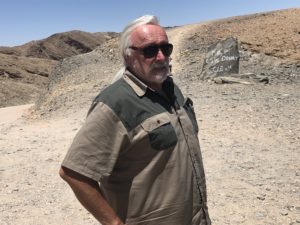
Our guide/driver, Udo, had a bad day, but all was forgiven. Photo by Karen Shigeishi-Waite.
Udo was convinced something was wrong under the hood – and kept trying to start the engine. Our German lady doctor made her diagnosis – we had run out of gas. I concurred (based on ample experience while driving in places as far-flung as Russia and Mexico). We informed an unhappy Udo of our expert assessment.
Fortunately, one of Udo’s compatriots came along, confirmed the empty tank theory, and returned with a jerry can. Problem solved. When we arrived at our hotel in Swakopmund, we settled in and Udo consumed an additional beer or two that evening. All was copasetic.
Still In Africa?
Swakopmund is a somewhat otherworldly resort town, if only because it seems grafted onto Namibia rather than of it. Many of the condo and villa dwellers are from South Africa, often of Boer or Afrikaner stock; others hale from adjacent African countries or from Europe.
This is not to say the town is unpleasant – it just isn’t particularly African.
There are things to do, see and eat. Not far away, in Walvis Bay, is a shallow lagoon, a RAMSAR World Heritage site, where 70- 80 percent of Africa’s flamingos feed and hang out in the winter.
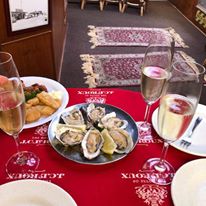
Oysters served during a boat cruise off Walvis Bay. Photo by Robert Waite.
There are also tour boats at the ready to take you away from shore and into the South Atlantic. You will be treated to up close and personal encounters with pelicans and seals – both have learned that it pays (in fish) to come aboard and meet the tourists. You will also likely see dolphins, sea lions and, if you are lucky, whales (Walvis is Afrikaans for whale).
But the biggest treat in the region is completely unexpected – oysters. It seems an enterprising individual in the 1980’s had the bright idea to import Chilean oysters to cultivate in the cool waters of the Benguela current, which flows up from the south.
It worked wonderfully and today Namibian-raised oysters are arguably as good as any you’ll find in places like Prince Edward Island, Puget Sound or Galway, Ireland.
Best of all, they serve them right on the boat – below deck, so that you don’t have to share with the pelicans or seals.
Damaraland
From Swakopmund we headed north into Damaraland, one of the most sparsely settled areas of Africa and home to the Damara people. Humans have been living in this harsh environment for thousands of years, as evidenced at the Twyfelfontein UNESCO World Heritage site, which features over 2,500 paintings and petroglyphs created by Bushman communities over a 6,000-year timeframe.
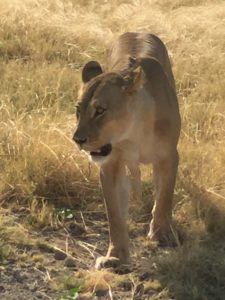
A lioness in Namibia’s Etosha National Park. Photo by Karen Shigeishi-Waite
Also worth visiting is the Living Museum of the Damara, a recreated Damaran village reached by entering what looks like a large boulder via a narrow passageway. Inside you will see Damara men and women in traditional dress (or undress – many of the women would not be out of place on a Cote d’Azur beach) demonstrating various aspects of what was an almost wholly self-sufficient way of life.
Yes, it’s touristy, but the attempt to faithfully depict a vanishing way of life is nonetheless worthwhile and your dollars help sustain them.
The final stop on our 12-day excursion was Namibia’s magnificent Etosha National Park. This park is notable for several reasons. To start, it is home to four of Africa’s Big Five – the elephant, lion, leopard and rhino. But it also represents a very early attempt at species and environmental protection. It was established as Namibia’s first conservation area in 1907, by the German colonial governor, Frederick von Lindequist.
Among the Best
While less well known than its counterparts in Kenya, Botswana or South Africa, Etosha deserves to be ranked among the very best of the continent’s game parks.
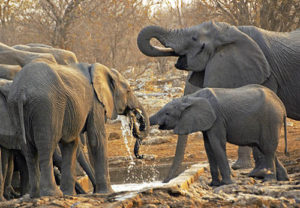
Elephants at watering hole in Etosha National Park in Namibia. Photo by Dennis Cox/WorldViews
Game viewing is largely focused around the waterholes, some of which are spring fed while others are supplied from a borehole. Not only is there an opportunity to see four of the Big Five (which we did), but there are a total of 114 different game species and more than 340 bird species present as well.
You will see countless numbers of giraffes, zebras, hyenas; several types of antelopes, including kudu, oryx and eland, as well as the black-faced impala.
The safari road system takes you to the far-flung corners of the park. In truth, the danger is not that you won’t see wildlife; it is that you’ll see so much you’ll become blasé.
After Etosha we made our way back to Windhoek. By this point Udo had fully recovered from his “Bad Day” and we, his passengers, who had set out originally as pods of strangers, were now fast friends, all happy we had chosen to visit a corner of Africa little known to many but with so much to offer to those who go.
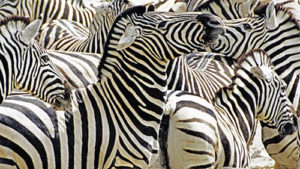
Burchell Zebras, Etosha National Park, Namibia. Photo by Dennis Cox/WorldViews
If You Go
“Namibian cuisine” conjures up images of a succulent springbok steak, a bag of cured kudu biltong or perhaps even the infamous fried mopane worm — chewy and spicy. We skipped the latter but did enjoy the game dishes. And as mentioned, the oysters are succulent and delicious – year-round.
In Swakopmund we stayed at the Swakopmund Plaza Beach Hotel; at Etosha National Park we stayed at two properties, Etosha Safari Camp and Mokuti Etosha Lodge. Both were excellent; staying at two lodgings allowed us to see more of the park.
Author Bio: Robert Waite has written on travel for almost 50 years. A former Pacific News Service correspondent in Eastern Europe, he is a professor at Seneca College in Toronto and Managing Partner at Waite + Co., a communications consulting firm with offices in Boston, Ottawa and Toronto.












One Response to Namibia: Dunes, Oysters, and Wildlife